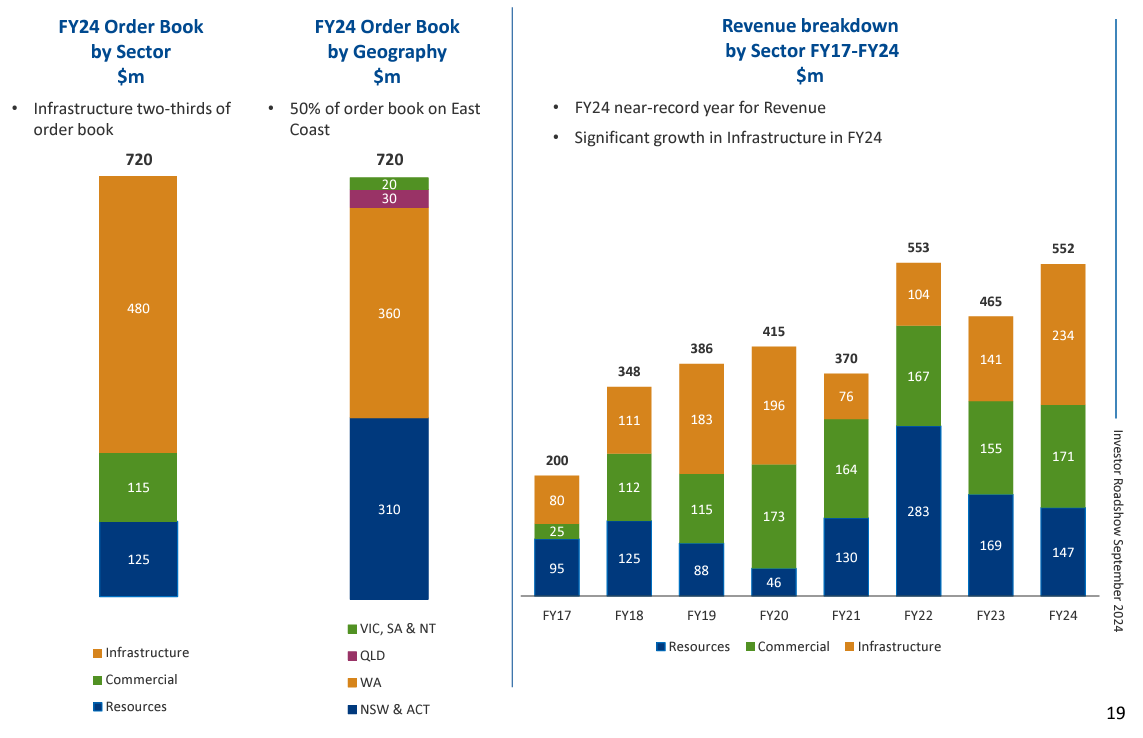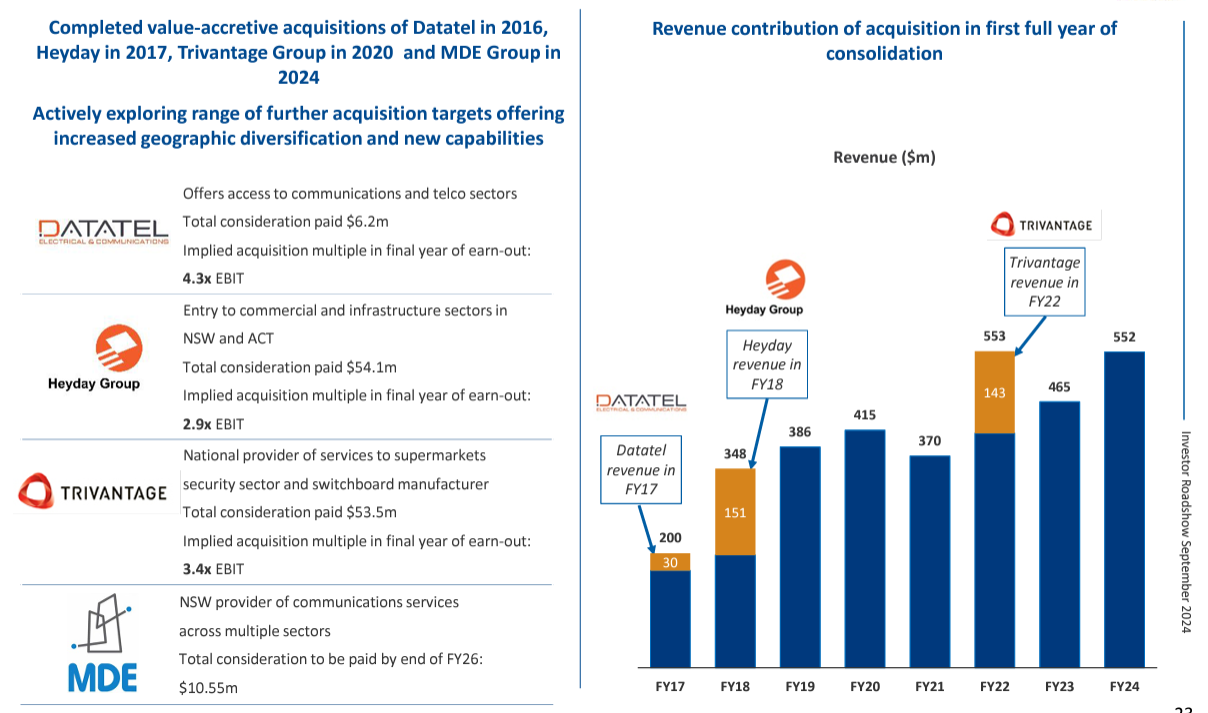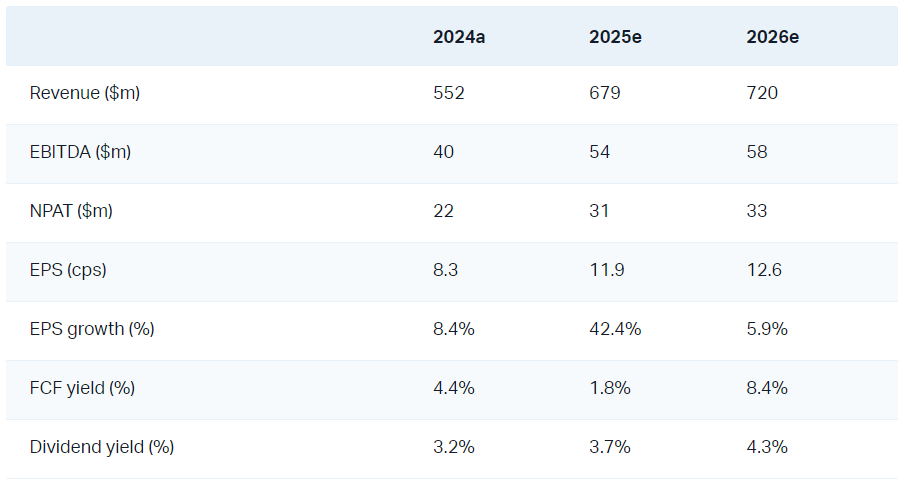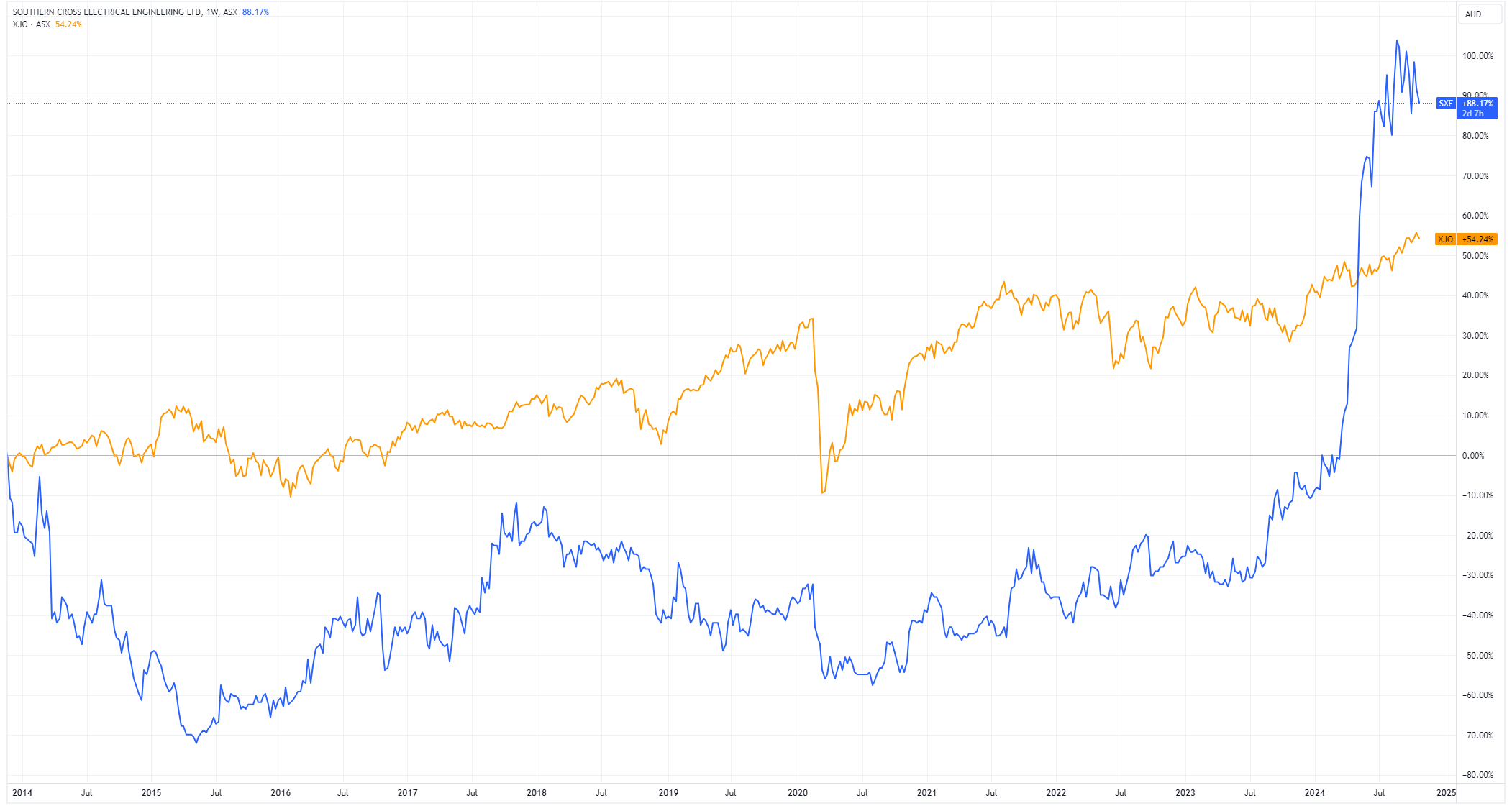A defensive stock riding two megatrends: AI and decarbonisation
Tech giants and other players are forecast to spend over US$1 trillion on AI infrastructure in the coming years, according to Goldman Sachs. But there's so far little to show for such a large capital outlay. Unless you're supplying the picks and shovels for this digital gold rush.
In this company deep dive, I'll be taking a closer look at Southern Cross Electrical Engineering (ASX: SXE) – A $460 million market cap provider of specialised electrical, instrumentation, maintenance and communication services. The stock is up 105% year-to-date, underpinned by strong earnings growth and major contract wins in the data centre and decarbonisation space.
To see where the industry is headed, I spoke to Southern Cross CFO Chris Douglass – covering recent order book trends, strategic priorities and company outlook.
At A Glance
- What do they do: Southern Cross offers project lifecycle services from initial design through to installation and ongoing maintenance across three broad sectors – Infrastructure, Commercial and Resources.
- Revenue breakdown: Infrastructure (42.4%), Commercial (30.9%) and Resources (26.6%) for FY24
- Leveraged to data and infrastructure: 'Infrastructure' is 42.4% of total revenue to become the largest revenue sector for the first time on record. Revenue for the segment rose 66% year-on-year to $234 million in FY24
- Growth rates: Since FY18, Southern Cross has grown its net profit after tax at a compound average growth rate of 17.3%
- Dividends: Southern Cross has maintained or grown its nominal dividend every year since FY17. Its dividend yield has sat around 3-4%
- Other interesting tidbits: Southern Cross currently has a record order book of $720 million (FY23: $610m). Infrastructure makes up two-thirds of the order book.
Order Book Trends
Southern Cross has a broad definition for 'infrastructure', including traditional segments like road and rail as well as emerging sectors such as renewables and data centres. Mr Douglass says the company has seen significant growth in its data centre business, with turnover increasing from $20 million per annum over the past five years to $50 million in FY24, with projections of $100 million for FY25.
"People ask us how long this data centre boom is going to go on for, and we just say look, nothing ever lasts forever, but in the timeframe that we look ahead, we don't see any end in sight to it," he said.
The company is currently bidding on a data centre job for a hyperscale cloud provider in Sydney next year. Mr Douglass explains that "the way data centres work is that we're bidding for a data centre that won't start construction until next year, and knowing the plans for it, it'll be a three or four-year construction project."
"So that's why we can see a work stream for four to five years in front of us, which is basically as far as a contractor ever looks out anyway."
He expects infrastructure to carry on growing both in real terms and as a percentage of the order book. This growth also reflects a "quieter" performance from the other sectors – Commercial and Resources.
"Commercial is a mixture of the work we do at the supermarkets, which is pretty stable and grows moderately every year, and then commercial buildings, particularly in Sydney and Canberra, which is quite a quiet area at the moment," he said, adding that "it was a big boom area for us, certainly went quiet during the COVID era, and probably hasn't picked up again. But in the longer term, we think it will come back."
The resource sector has also been relatively quiet, "There are no major projects in the pipeline for two to three years ... we're budgeting $120 million in resources this year, and that's probably where we will be for the next few years."

Managing a Growing Pipeline
Southern Cross has not struggled to source labour which has been problematic in other parts of the construction industry. “We are a tier-one electrical subcontractor. We pay at the top end of the market. We have a fabulous safety record." he said, adding that "we can flex our workforce up and down and can find workers. Labor is not a constraint for future growth."
As an example of this Southern Cross downsized its workforce in mid-2023 to 1,400 employees, when a couple of large resources projects came to an end. As of 30 June, its workforce had risen to 1,700 and is currently at 1,900.
"In the long term I suspect there may not be enough electricians in Australia to perform everything in the pipeline," he said. "Australian regulations require all electrical work to be performed by qualified Australian electricians, limiting the ability to import workers, however we believe given our market position we will be fine.We increased our group bonding capacity from $100 million to $150 million in May, and we've got $54 million of headroom at the moment in those facilities. For bonding our projects, you have to put up either 5 or 10% of the contract value in bonds at the start of a project and then you get them back at the end. This headroom would allow us to perform a materially greater volume of work."
Southern Cross downsized its workforce in mid-2023 to 1,400 employees, when a couple of large resources projects came to an end. As of 30 June, its workforce risen to 1,700 and currently at 1,900. "So we can flex our workforce up and down and don't struggle to find workers. Labor is not a constraint for future growth. "
Cash Insights
Southern Cross had $84.1 million cash and zero debt as at 30 June 2024. While it may seem like a large amount relative to the company's market cap (approximately $460 million) there's more than meets the eye. Here are a few key insights:
- Bonding for projects: "We increased our group bonding capacity from $100 million to $150 million in May, and we've got $54 million of headroom at the moment in those facilities. For bonding our projects, you have to put up either 5 or 10% of the contract value in bonds at the start of a project and then you get them back at the end. This headroom would allow us to perform a materially greater volume of work."
- A capital light business: "If you think about it, electricians don't need a lot of equipment ... the group's CAPEX expenditure is 3 million bucks a year and it'll stay constant at that level."
- Holding cash for working capital: "Being the electricians right at the end, we get asked to accelerate, which means putting on extra people. That has a big working capital impact in the short term. So, that's the argument for why we need to maintain quite a big float of cash on the balance sheet to cope with those peak points. Of that $84 million, I'd say something like $30 to 40 million is required just as that working capital float."
Given the final point, this leaves the business with $30-40 million surplus cash on the balance sheet for potential M&A activity. Mr Douglas says there's plenty of opportunity out there. But few fit the criteria.
The M&A Criteria
"At the moment, between me and the CEO Graham, we probably get an opportunity landing on our desk literally every week. And we've only done an acquisition every two years, so we're turning away 99 out of 100," he says.
Their checklist revolves around five key considerations:
- What do they do and does that fit into key categories: Such as geographic diversification or an adjacent/complementary capability?
- Culture: If this can't align, there's no point in going ahead with the acquisition.
- Good management: We don't have a big team of managers to inject into our acquisition targets. They've got to come with their own management who want to run the business.
- Is there a growth story for that business: If there's no growth story, there's no point in doing the acquisition.
- Price: Only when we come to the fifth consideration, we talk about price. How much do they want for their business.

In terms of what they're on the look out for, Mr Douglas noted:
- Geography: "We're not very strong in Brisbane Metro, Melbourne Metro, or Perth Metro. So finding a Heyday look-alike for those three cities could be an easy geographic diversification."
- Transformational: "I'm not saying this is what we're going to do - but defence is becoming a big thing now. There's going to be a lot of defence expenditure coming."
- Adjacent Skill sets: "As the Group has got wider and more diverse it opens up space for bringing in more adjacent offerings to our core electrical capability. Our recent acquisition of MDE to add a communications capability to Heyday’s electrical services was a great example of this."
Bell Potter: "Electrifying"
Bell Potter reiterated a Buy rating with a $2.25 target price (previously $2.10) following the company's FY24 result on 21 August.
"Southern Cross brings key small cap exposure to several emerging and structural themes, including the proliferation of data centre construction across Australia, decarbonisation of the Australian economy, electrification of industries and the build-out of large-scale critical infrastructure," the analysts said.
"The company enters FY25 with a record order book and a tender pipeline that could support further growth."
In terms of earnings outlook, the analysts forecast:

What could go wrong?
For my last question, I asked the following: If I put my investor hat on, Southern Cross is trading at 22x FY24 earnings, which isn't that expensive given its earnings outlook. Your slides have also shown that seven key clients have consistently provided approximately 45% of average annual revenues over the past eight years, so there's some earnings stability there. So what could go wrong?
"We're a contractor - it's never easy in contracting. You work very hard and try to avoid problem projects, but you're constantly trying to manage that risk, so things can go wrong in contracting - we have to give that warning," explains Mr Douglass.
"But you're right, otherwise, the macro environment looks as good as it's ever been, I would say. But things can go wrong at a macro level as well – who foresaw COVID?"
He also acknowledged that the share price has only started to rally strongly in the past 12 months after trading mostly sideways since 2015.

"The global situation has some alarm bells as well. But if the macro situation stays good and we can keep control of our projects, then yes, we should be able to deliver some pretty good outcomes going forward."
This article first appeared on Market Index on Thursday 24 October 2024.
4 topics
1 stock mentioned

